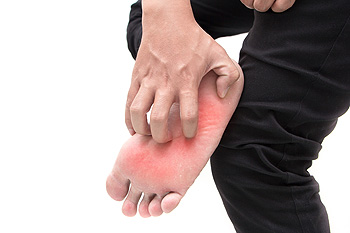Where Does The Fungus That Causes Athlete’s Foot Live?
Monday, 16 September 2019 00:00 The most common type of skin infection caused by a fungus is referred to as athlete’s foot. This fungus lives and thrives in warm and moist environments that often consist of public pools, shower room floors, locker rooms and surrounding areas. Noticeable symptoms that often accompany this condition can include severe itchiness on the soles of the feet, between the toes, and the skin may crack and appear scaly. If you are affected by athlete’s foot, moderate relief can be found when an antifungal medication is used. This can be applied in the form of a spray, cream, or lotion. There are methods that can be taken which may help to prevent contracting this condition. These can include wearing appropriate shoes while in moist environments, in addition to keeping your feet clean and dry. If you are afflicted with a severe case of athlete’s foot, it is strongly suggested that you consult with a podiatrist who can properly treat this condition.
The most common type of skin infection caused by a fungus is referred to as athlete’s foot. This fungus lives and thrives in warm and moist environments that often consist of public pools, shower room floors, locker rooms and surrounding areas. Noticeable symptoms that often accompany this condition can include severe itchiness on the soles of the feet, between the toes, and the skin may crack and appear scaly. If you are affected by athlete’s foot, moderate relief can be found when an antifungal medication is used. This can be applied in the form of a spray, cream, or lotion. There are methods that can be taken which may help to prevent contracting this condition. These can include wearing appropriate shoes while in moist environments, in addition to keeping your feet clean and dry. If you are afflicted with a severe case of athlete’s foot, it is strongly suggested that you consult with a podiatrist who can properly treat this condition.
Athlete’s foot is an inconvenient condition that can be easily reduced with the proper treatment. If you have any concerns about your feet and ankles, contact Dr. Eugenio Rivera from Calo Foot & Ankle Specialists. Our doctor will treat your foot and ankle needs.
Athlete’s Foot: The Sole Story
Athlete's foot, also known as tinea pedis, can be an extremely contagious foot infection. It is commonly contracted in public changing areas and bathrooms, dormitory style living quarters, around locker rooms and public swimming pools, or anywhere your feet often come into contact with other people.
Solutions to Combat Athlete’s Foot
- Hydrate your feet by using lotion
- Exfoliate
- Buff off nails
- Use of anti-fungal products
- Examine your feet and visit your doctor if any suspicious blisters or cuts develop
Athlete’s foot can cause many irritating symptoms such as dry and flaking skin, itching, and redness. Some more severe symptoms can include bleeding and cracked skin, intense itching and burning, and even pain when walking. In the worst cases, Athlete’s foot can cause blistering as well. Speak to your podiatrist for a better understanding of the different causes of Athlete’s foot, as well as help in determining which treatment options are best for you.
If you have any questions please feel free to contact our office located in Bellaire, TX . We offer the newest diagnostic and treatment technologies for all your foot and ankle needs.









